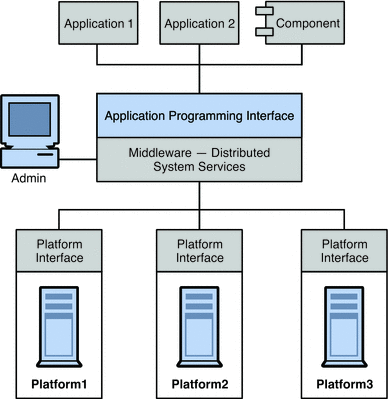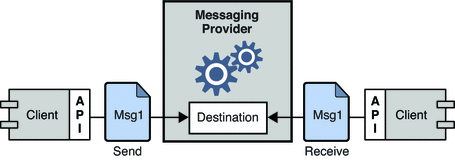Message-Oriented Middleware (MOM)
Because businesses, institutions, and technologies change continually, the software systems that serve them must be able to accommodate such changes. Following a merger, the addition of a service, or the expansion of available services, a business can ill afford to recreate its information systems. It is at this most critical point that it needs to integrate new components or to scale existing ones as efficiently as possible. The easiest way to integrate heterogeneous components is not to recreate them as homogeneous elements but to provide a layer that allows them to communicate despite their differences. This layer, called middleware, allows software components (applications, enterprise java beans, servlets, and other components) that have been developed independently and that run on different networked platforms to interact with one another. It is when this interaction is possible that the network can become the computer.
As shown in Figure 1–1, conceptually, middleware resides between the application layer and the platform layer (the operating system and underlying network services).
Figure 1–1 Middleware

Applications distributed on different network nodes use the application interface to communicate without having to be concerned with the details of the operating environments that host other applications nor with the services that connect them to these applications. In addition, by providing an administrative interface, this new, virtual system of interconnected applications can be made reliable and secure. Its performance can be measured and tuned, and it can be scaled without losing function.
Middleware can be grouped into the following categories:
-
Remote Procedure Call or RPC-based middleware, which allows procedures in one application to call procedures in remote applications as if they were local calls. The middleware implements a linking mechanism that locates remote procedures and makes these transparently available to a caller. Traditionally, this type of middleware handled procedure-based programs; it now also includes object-based components.
-
Object Request Broker or ORB-based middleware, which enables an application’s objects to be distributed and shared across heterogeneous networks.
-
Message Oriented Middleware or MOM-based middleware, which allows distributed applications to communicate and exchange data by sending and receiving messages.
All these models make it possible for one software component to affect the behavior of another component over a network. They are different in that RPC- and ORB-based middleware create systems of tightly-coupled components, whereas MOM-based systems allow for a looser coupling of components. In an RPC- or ORB-based system, when one procedure calls another, it must wait for the called procedure to return before it can do anything else. As mentioned before, in these models, the middleware functions partly as a super-linker, locating the called procedure on a network and using network services to pass function or method parameters to the procedure and then to return results.
MOM-based systems allows communication to happen through the asynchronous exchange of messages, as shown in Figure 1–2.
Figure 1–2 MOM-Based System

Message Oriented Middleware makes use of messaging provider to mediate messaging operations. The basic elements of a MOM system are clients, messages, and the MOM provider, which includes an API and administrative tools. The MOM provider uses different architectures to route and deliver messages: it can use a centralized message server or it can distribute routing and delivery functions to each client machine. Some MOM products combine these two approaches.
Using a MOM system, a client makes an API call to send a message to a destination managed by the provider. The call invokes provider services to route and deliver the message. Once it has sent the message, the client can continue to do other work, confident that the provider retains the message until a receiving client retrieves it. The message-based model, coupled with the mediation of the provider, makes it possible to create a system of loosely-coupled components. Such a system can continue to function reliably, without downtime, even when individual components or connections fail.
One other advantage of having a messaging provider mediate messaging between clients is that by adding an administrative interface, you can monitor and tune performance. Client applications are thus effectively relieved of every problem except that of sending, receiving, and processing messages. It is up to the code that implements the MOM system and up to the administrator to resolve issues like interoperability, reliability, security, scalability, and performance.
So far we have described the advantages of connecting distributed components using message-oriented middleware. There are also disadvantages: one of them results from the loose coupling itself. With an RPC system, the calling function does not return until the called function has finished its task. In an asynchronous system, the calling client can continue to load work upon the recipient until the resources need to handle this work are depleted and the called component fails. Of course, these conditions can be minimized or avoided by monitoring performance and adjusting message flow, but this is work that is not needed with an RPC system. The important thing is to understand the advantages and liabilities of each kind of system. Each system is appropriate for different tasks. Sometimes, you will need to combine the two kinds of systems to obtain the exact behavior you need.
Figure 1–3 shows the way a MOM system can enable communication between two RPC-based systems. The left side of the figure shows an application that distributes client, server, and data store components on different networked nodes for improved performance. This is a discount airline reservation system: an end user pays a fee to use this service, which allows it to find the lowest available fare for given destinations and times. The data store holds information about registered users and about airlines that participate in this program. Based on the user’s request, logic on the server queries participating airlines for prices, sorts through the information, and presents the three lowest bids to the user. The right side of the picture shows an RPC-based system that represents the ticket/reservation system for any one of the participating airlines. The right side of the picture would be replicated for as many airlines as the discounter is connected to. For each such airline, the data store would hold information about available flights (seating, flight times, and prices). The server component would update that information in response to data input by the end user. The airline server also subscribes to the MOM service, accepting requests for information from the discount reservation system and returning seating and pricing information. If a customer decides to purchase a discounted ticket on a PanWorld flight, the server component for that system would update the information in the data store and then either generate a ticket for the requester or send a message to the discounting service to generate the ticket.
Figure 1–3 Combining RPC and MOM Systems

This example illustrates some of the differences between RPC and MOM systems. The difference in the way in which distributed components are coupled has already been mentioned. Another difference is that while RPC systems are often used to distribute and connect client and server components in which the client is often an end-user, with MOM systems, clients are often heterogeneous software components that can only interoperate by means of messaging.
A more serious problem with MOM systems arises from the fact that MOMs are implemented as proprietary products. What happens when your company, which depends on SuperMOM-X acquires a company that uses SuperMOM-Y? To resolve this problem, a standard messaging interface is needed. If both SuperMOM-X and SuperMOM-Y implemented this interface, then applications developed to run on one system could also run on the other. Such an interface should be simple to learn but provide enough features to support sophisticated messaging applications. The Java Message Service (JMS) specification, introduced in 1998, aimed to do just that. The next section describes the basic features of JMS and explains how the standard was developed to embrace common elements of existing proprietary MOM products as well as to allow for differences and further growth.
- © 2010, Oracle Corporation and/or its affiliates
